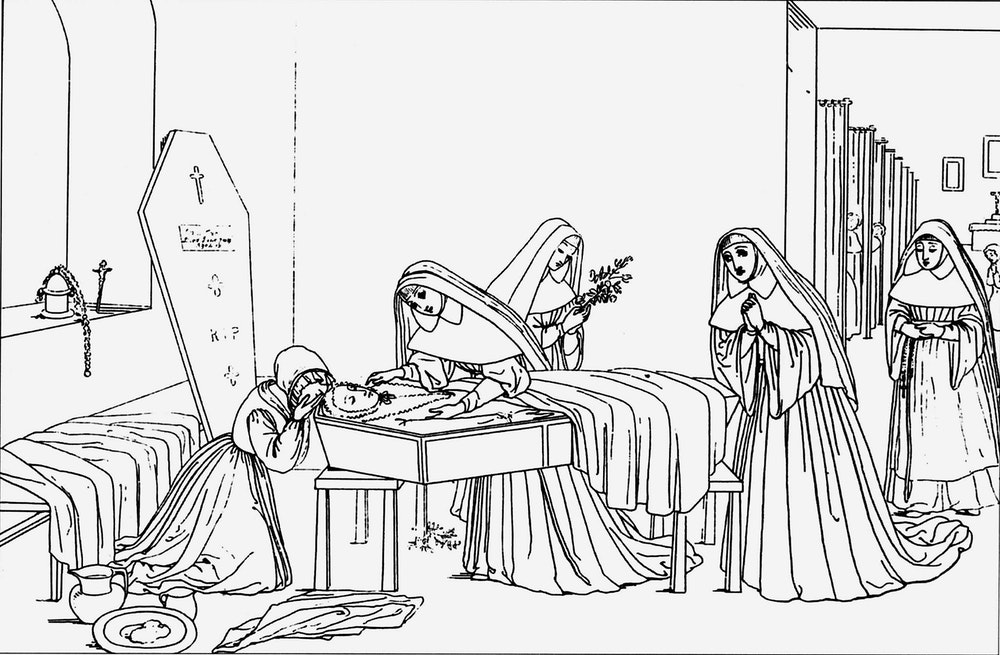In this year’s Lenten reflection series, seven sisters offer their personal stories and insights on each of the Corporal Works of Mercy and how acts of mercy can have a profound impact on the lives of our sisters and brothers. Accompanying these reflections are line drawings by Sister Mary Clare Agnew, a contemporary of Catherine McAuley, which illustrate the Sisters of Mercy in ministry in 1830s Ireland. The reflection series also includes reflections for Ash Wednesday, Palm Sunday, Holy Thursday and Easter.
By Sister Sheila Stevenson, Pastoral administrator, St. Marianne Cope Roman Catholic Parish, Henrietta, New York
Walking into the parish office on a mild, sunny winter day with my ever-present, “to do” list, I am energized to face the week ahead. Within five minutes of taking off my coat, the phone rings and our administrative assistant tells me it’s Pete, a longtime, faithful, involved parishioner with a lovely wife, Jackie. I had just seen them at Mass yesterday. Delighted, I answer brightly but stop short when I hear Pete’s sobs on the other end. In a breaking voice, he says, “Sister, Jackie is dead on the bathroom floor, can you come?” And so begins the Corporal Work of Mercy, to bury the dead.
I arrive just after the police, paramedics and medical examiner. Pete is sitting in his sunroom, which is alive with plants of all varieties. His tears flow openly. There is disbelief in our halting conversation, and profound moments of silence interrupted only by questions carefully and compassionately asked by the professionals. Family members begin arriving, each with their own sorrow and tears at the unexpected death of a mother and grandmother so loved. Eventually, we are allowed upstairs where Jackie has been laid in her bed, neatly and beautifully as if only peacefully sleeping. A daughter in another state is contacted by FaceTime, so that she too can see her mom in a peaceful state in death and join in our prayers for Jackie. And so continues the Corporal Work of Mercy, to bury the dead.
In the days to come, arrangements are made for a wake and funeral Mass. Readings and hymns are chosen carefully by family members, people are invited to read or bring forth the gifts or speak words of remembrance at the Mass. There are conversations with the bereaved that include more than just the needs for the rituals but are part of the grieving process. And so continues the Corporal Work of Mercy, to bury the dead.

The wake takes place with the gathered family being led in prayer, stating that the “bonds of friendship we have known in life are not destroyed in death.” The funeral Mass follows the next day and a lovely green burial takes place at the cemetery. Afterwards, people gather to share stories and celebrate Jackie’s life. Her legacy of faith and goodness will be remembered always. In the ensuing weeks and months, masses are offered, Jackie’s grave is visited and stories continue to be told. Grief books are sent from the parish to the bereaved every three months for a year and a parish grief group assists Pete as he copes with a new life without Jackie. And so continues the Corporal Work of Mercy, to bury the dead.
Mercy and compassion are never more needed than at the time of death and all that surrounds this often unexpected period. To bury the dead is a call and gift extending beyond the act of burying. It can be cultivated over time; I know this from my own life.
At one time I said to a group of Sisters of Mercy with whom I was working, “I’ll do anything, but I don’t do death, someone else will have to take that.” Now as a pastoral administrator in a large parish, I “do death” almost every week. The call to perform the Corporal Works of Mercy is really not negotiable. As Sisters of Mercy, our call is to offer mercy, compassion and the love of God to each person, in life and death, to the bereaved and the deceased, and so we bury the dead.